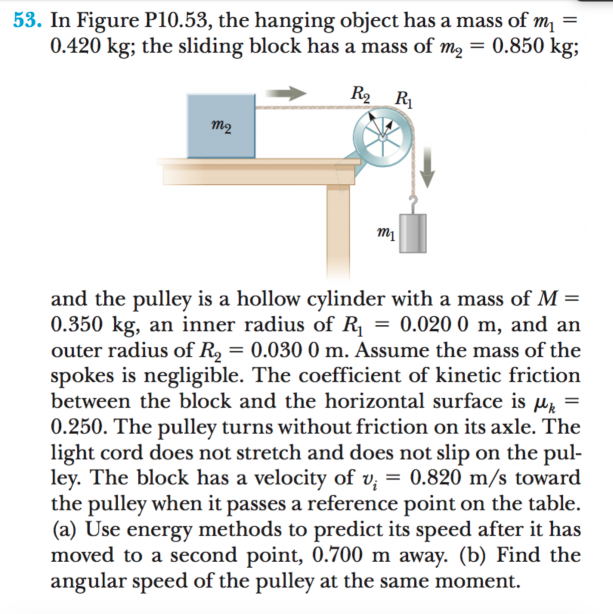53. In Figure P10.53, the hanging object has a mass of m, = 0.420 kg; the sliding block has a mass of m, = 0.850 kg; R2 R m2 and the pulley is a hollow cylinder with a mass of M = 0.350 kg, an inner radius of R, = 0.020 0 m, and an outer radius of R, = 0.030 0 m. Assume the mass of the spokes is negligible. The coefficient of kinetic friction between the block and the horizontal surface is µz 0.250. The pulley turns without friction on its axle. The light cord does not stretch and does not slip on the pul- ley. The block has a velocity of v; = 0.820 m/s toward the pulley when it passes a reference point on the table. (a) Use energy methods to predict its speed after it has moved to a second point, 0.700 m away. (b) Find the angular speed of the pulley at the same moment.
53. In Figure P10.53, the hanging object has a mass of m, = 0.420 kg; the sliding block has a mass of m, = 0.850 kg; R2 R m2 and the pulley is a hollow cylinder with a mass of M = 0.350 kg, an inner radius of R, = 0.020 0 m, and an outer radius of R, = 0.030 0 m. Assume the mass of the spokes is negligible. The coefficient of kinetic friction between the block and the horizontal surface is µz 0.250. The pulley turns without friction on its axle. The light cord does not stretch and does not slip on the pul- ley. The block has a velocity of v; = 0.820 m/s toward the pulley when it passes a reference point on the table. (a) Use energy methods to predict its speed after it has moved to a second point, 0.700 m away. (b) Find the angular speed of the pulley at the same moment.
Principles of Physics: A Calculus-Based Text
5th Edition
ISBN:9781133104261
Author:Raymond A. Serway, John W. Jewett
Publisher:Raymond A. Serway, John W. Jewett
Chapter10: Rotational Motion
Section: Chapter Questions
Problem 40P: In Figure P10.40, the hanging object has a mass of m1 = 0.420 kg; the sliding block has a mass of m2...
Related questions
Question

Transcribed Image Text:53. In Figure P10.53, the hanging object has a mass of m, =
0.420 kg; the sliding block has a mass of m, = 0.850 kg;
R2 R
m2
and the pulley is a hollow cylinder with a mass of M =
0.350 kg, an inner radius of R, = 0.020 0 m, and an
outer radius of R, = 0.030 0 m. Assume the mass of the
spokes is negligible. The coefficient of kinetic friction
between the block and the horizontal surface is µz
0.250. The pulley turns without friction on its axle. The
light cord does not stretch and does not slip on the pul-
ley. The block has a velocity of v; = 0.820 m/s toward
the pulley when it passes a reference point on the table.
(a) Use energy methods to predict its speed after it has
moved to a second point, 0.700 m away. (b) Find the
angular speed of the pulley at the same moment.
Expert Solution
Trending now
This is a popular solution!
Step by step
Solved in 9 steps with 9 images

Recommended textbooks for you

Principles of Physics: A Calculus-Based Text
Physics
ISBN:
9781133104261
Author:
Raymond A. Serway, John W. Jewett
Publisher:
Cengage Learning

Physics for Scientists and Engineers with Modern …
Physics
ISBN:
9781337553292
Author:
Raymond A. Serway, John W. Jewett
Publisher:
Cengage Learning

Physics for Scientists and Engineers
Physics
ISBN:
9781337553278
Author:
Raymond A. Serway, John W. Jewett
Publisher:
Cengage Learning

Principles of Physics: A Calculus-Based Text
Physics
ISBN:
9781133104261
Author:
Raymond A. Serway, John W. Jewett
Publisher:
Cengage Learning

Physics for Scientists and Engineers with Modern …
Physics
ISBN:
9781337553292
Author:
Raymond A. Serway, John W. Jewett
Publisher:
Cengage Learning

Physics for Scientists and Engineers
Physics
ISBN:
9781337553278
Author:
Raymond A. Serway, John W. Jewett
Publisher:
Cengage Learning

Physics for Scientists and Engineers: Foundations…
Physics
ISBN:
9781133939146
Author:
Katz, Debora M.
Publisher:
Cengage Learning

Physics for Scientists and Engineers, Technology …
Physics
ISBN:
9781305116399
Author:
Raymond A. Serway, John W. Jewett
Publisher:
Cengage Learning